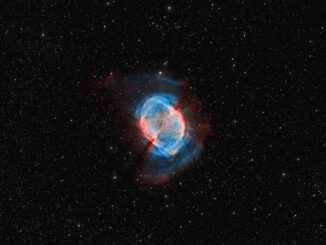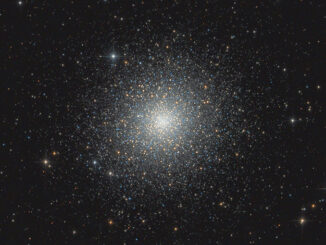
When looking to observe one of Cassiopeia’s wonderland of bright open clusters, don’t make the common and understandable mistake of heading in the direction of either of the constellation’s Messier-designated clusters, Messier 52 or Messier 103, fine clusters though they undoubtably are! Instead, your first port of call should be NGC 457 (Caldwell 13), an eye-catching open cluster with two famous nicknames, the Owl Cluster and the more recently acquired ET Cluster. In its time it’s also been called the Phi Cassiopeiae Cluster (see below).
Shining brightly at magnitude +6.4, brighter than either of the Messier clusters, NGC 457 can be seen by eagle-eyed (or should I say owl-eyed?!) individuals at pristine observing locations. For the majority of UK, it’s an easy object for 10 × 50 binoculars, appearing as a fuzzy patch of light, and a small telescope will readily pick out (resolve) a couple of dozen of its member stars.
If all this good news isn’t enough, the Owl is circumpolar (never-setting) from the UK and peaks in altitude at the zenith (overhead), which means that it can be observed all night.

How to observe:
NGC 457’s location is easy to pin down, owing to the fifth-magnitude star phi (φ) Cassiopeiae (Cas), now considered a cluster member and serving as one of the Owl’s eyes, lying handily just two degrees south-south-east of Ruchbah (delta [δ] Cas). Cassiopeia’s famous and bright ‘W’ asterism (star pattern), which includes Ruchbah, is one of the most recognisable in the entire sky.
By nightfall, which occurs by 9pm BST from London, Cassiopeia is located 45 degrees high in the east-north-east and climbing. NGC 457 lies high overhead at around the small hours.
A small telescope of about 80mm [~ three inches) in aperture can resolve around 25 individual stars within NGC 457, rising to nearly 50 through a telescope in the 150mm (six-inch) class, spread out across an apparent diameter of 13’. These cluster members, of which there are thought to be around 200 in total, are arranged in noticeable lines and curves, which give rise to its Owl moniker and makes it an attractive sight.
The aforementioned star phi and the nearby star (to the south-west) magnitude +7 HIP 6229 represent the bird’s eyes, though they also remind some of the eyes of ET, the Extra-Terrestrial, Stephen Spielberg’s gentle alien creation.



